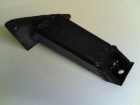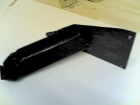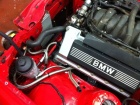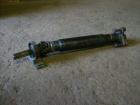Engine Swap - M6x
Not much compares to a V8. The thunderous roar, the pulsing of power at idle and all that wonderful, wonderful torque make a V8 an engine swap wet dream for many, which is why BMW fitted their M6x family of V8s into the bigger cars.
Fitting the eight-cylinder magnificence in an E30 engine bay is therefore a winning combination, and the engine swap of true heroes, but it's not for the faint-hearted. If you're up to the challenge, here's how to fit a monster 4.0 litre V8 M6x engine into your E30.
Contents
Overview
Taking on this challenge requires some serious guts, cash and lateral thinking. Before you buy a single bolt, bear in mind that the E30 pre-dates all BMW V8 engines; the earliest V8 is 1992. Therefore, some significant customisation will be required to squeeze the prodigious bulk of the M6x into the engine bay. The plus side of this is that any E30 can be used as a starting project, since none of the original components will be suited to the task anyway. Our favourite is to use a chrome pre-facelift shell, complete with the 316 badge on the boot lid, just for giggles.
The V8 comes in two distinct flavours; M60 and M62, with sizes ranging from 3.0 to 4.6 litres. They are almost identical in size, but the power output differs considerably; the M60 3.0's 215bhp seems almost anaemic compared to the 282hp of the larger 4.0 litre M60 unit. The M62 has similarly varying outputs, with the largest M62 kicking out an eye-watering 342hp - if you want any more than that, you're entering S62 territory.
Considering the complexity of the build, it's only worth doing if you use one of the bigger engines; either the M60B40, M62B44 or M62B46.
With that in mind, most of the running gear will involve replacing to cope with the dramatically increased power. Besides the engine, you'll also need to source a gearbox and clutch, propshaft and differential to get the power to the back wheels. Custom mounts will need to be sourced or built to hold it all together. Around the engine, changes need to be made to the radiator system, and the brake servo will need to be moved or replaced to accommodate the engine. You'll also need to find an exhaust solution. Another guarantee is the brakes; they will need to be substantially upgraded to cope, otherwise you'll crash at the first corner.
For a more comprehensive list, check out the parts list.
Parts List
The parts list is both lengthy and comprehensive. Click each part for more info.
- Full M6x Engine with all ancillaries (injectors, MAF, inlet, coil packs, alternator)
- Engine mounts
- Complete engine loom
- Gearbox
- Clutch
- Propshaft
- Differential
- Exhaust including manifolds
- Fan
- Radiator
- Gear bridge
- Brake servo
Engine
There's no point in doing this swap if you're not going to use a big V8. Both the 3.0 litre M60 and 3.5 litre M62, while grunty, will not justify the hundreds of hours and thousands of pounds that this swap entails - even if the engine is free.
Therefore the engine options are:
- M60B40 - fitted to the E31, E32, E34 and E38
- M62B44 - fitted to the E38 and E39
- M62B46 - fitted to the E38, E39 and E53
Whether M60 or M62, all engines use an alloy block and head. After 1998, the M62 engines were fitted with VANOS. Despite the M62 being the more modern engine, we still favour the older, simpler M60 lump. For starters it's a sturdier construction which doesn't suffer from the broken chains that the M62 is becoming renowned for, and it also has a much simpler wiring setup.
If you want to make the best of both, a combination is to use an M62 4.4 litre block, coupled with M60 4.0 heads and chain, running an M60 wiring loom and ECU. This gives the best performance without compromising on reliability.
All engines install in the same manner; however, the later M62 engines will be fitted with EWS. This means you need the correct key and receiver for the car, or have the EWS disabled somehow.
Mounts
Because of the size, it's essential to get the M6x engine properly placed. This isn't just a matter of squeezing it into the available space, but also to ensure that it's not so far forward that it upsets the handling of the car.
To solve this, you can either buy custom mounts, or make your own. We do recommend purchasing them, with the kit from E30.de providing the best possible fit. If making them yourself, you need to comprehend BMW's bizarre decision to pass the remote oil filter plumbing through the left-hand mount. Because of this, we recommend keeping the original mount fitted to that side, and simply fabricating an extender to mate the original to the rubber bush on your chassis rail.
To help you keep things lined up, the distance between the engine mount centres measured across the subframe is 610mm exactly.
Oil Filter
One of the most prominent features of the V8 engine is the oil filter, which sits on the front corner of the engine. While handy for servicing, it's a right pain in the proverbial in an E30, where it hinders the fitting of the radiator hose. At a push the housing can be rotated, but for an improved engine bay we recommend relocating the oil filter using a remote housing.
The remote filter can be sourced from an E34, as well as its fittings. You'll just need some longer oil hoses to reach your chosen mounting location. For mounting, we recommend the spot behind the front headlight.
Drivetrain
Once you've fitted your engine, you'll want that power to be hitting the back wheels as efficiently as possible. With that in mind, you'll need to select the best combination for you from these three components; the Flywheel, the Gearbox and the propshaft.
Gearbox
There are three gearboxes to choose from; either a 5- or 6-speed manual gearbox, or an automatic. The choice is entirely up to you, but what you buy will directly affect which differential you use. To explain; the auto box on an E32 730i V8 is a 5 speed, the A5S310Z with the 0.74 overdrive fifth. In comparison, a five speed manual V8 box has a direct drive non overdrive fifth so you'll need a nice tall diff to cope - a 3.25 M3 diff will be ideal. The six speed units on the 540i and 840i used the same ratios but with an overdrive sixth which will allow for a lower ratio diff.
The 5-speed box can be found in the E34 530i cars, and is a stronger unit. The downside of using the 5-speed box is the requirement for a custom clutch, as the 3.0 litre unit simply can't cope with 4.0 litre power. It can also feel a bit over-revved at motorway speeds unless you've found a significantly low-geared differential.
The 6-speed from the 540i offers a final gear, which provides a faster top speed if mated to the correct differential. However, it requires a custom propshaft to mate up to the differential; no standard solution is available. If you're using a 6-speed gearbox you can use either the M60B40 or M62B44 clutch and flywheel. However, these two can't be mixed as they have different size clutch discs.
Unfortunately, gearboxes from V12 engines do not fit; they have the wrong bolt pattern for the V8 engine.
Flywheel
The flywheel will come with whatever engine you choose to fit, but it has a direct impact on your clutch and gearbox options. Fortunately it's possible to mix and match the flywheels across the M6x engine range - the key thing is that they are paired with a suitable clutch due to their sizes - you can't mate an M62 clutch to an M60 flywheel.
Clutch
You'll need the best possible clutch if you're going to make use of all that lovely lovely torque. Unfortunately they're one of the most problematic parts of the build, as they're so specific to both the flywheel and gearbox, meaning it's nigh-on impossible to mix and match components without needing a custom part at some point. This is all due to the varying component sizes used throughout the M6x family.
The M60B40 clutch disc is 265mm and M60B30 clutch disc 240mm, meaning they're incompatible. In addition, the other strong V8 240mm clutch discs and pressure plates, as used in the M62B44 and S62B49, have 6-speed clutch shaft holes and thus are not suitable for 5-speeder. Therefore, if you've opted to use a 5-speed gearbox then you can't use an off-the-shelf BMW clutch - you will have to contact a specialist clutch supplier. Helix can supply one if you ask nicely.
M60B40 and M62B44 friction plates also have the larger diameter clutch shaft hole compared to M60B30 / M62B35 friction plates (6speed vs 5speed 'box). Don't mix them up.
Propshaft
Your choice of propshaft is entirely dependent on your gearbox. If using the 5-speed gearbox then you will be able to mount the propshaft from the E36 328i, with the only modification being the fitting of an E30 centre bearing.
If you've chosen to use the 6-speed gearbox then you're committing yourself to a custom propshaft. A good place to start is to use the automatic propshaft from an E32 74oi automatic, and weld on the joint and splines from a standard E30 propshaft. This will allow you to use the standard E30 centre bearing, and will bolt up as if it were factory made.
Gear Selector
Because of the difference in length of the gearbox, you'll have to get creative with your gear shifters if you want them to mount in the standard hole in the transmission tunnel. You'll therefore need to cut the existing selector rod and mount down to size and then rejoin them. The selector rod can be welded together, but the aluminium mount will either require someone with alloy welding skills, or a bolted "sleeve" to hold it together.
Differential
This needs to be chosen to match your gearbox due to the ratios you have available. Most people agree that the lower the ratio the better, with a 2.93 ratio differential being close to ideal. A 3.15 diff is also good, but anything above 3.25 starts to feel stressed at motorway speeds, where the 3000+ rpm of a V8 quickly becomes tiring.
Cooling
The complex design of the M6x engines makes for a labyrinthine network of coolant channels and pipework, and it's essential that you get significant flow and proper cooling to prevent the engine overheating, which the V8 likes to do. Because of that, you'll need to install a big enough radiator for the job, as well as an electric fan to assist it in town and heavy traffic scenarios.
Radiator
These engines run hot, so you'll need a radiator that can cope. While the radiator from a donor E34 may be up to the job, its physical size won't fit between the chassis rails of an E30 so you'll have to resort to some butchering to make it fit. Far easier is to use a radiator from an E36 M3, or even a Z3 radiator. Either of these units will drop into place using the existing mounts.
Another radiator that fits is the E28 535i unit, athough mounting depends on your car. If it is a tropical rad in a pre-facelift car, it should drop straight in. If your car is a facelift, you will probably have to remove the side mounts next to the chassis legs and add the bottom mounts to the lower leg of the radiator cradle. The top mounts are the same.
If you're really worried about your cooling potential, a thicker alloy unit can be bought from Mishmoto.
Fan
Since space is very tight we'll be fitting an electric fan wired up to an electric switch so that it activates automatically. The E36 electric aircon fan will bolt straight on. For more info, learn about fitting an electric fan.
Temp Switch
To ensure the electric fan kicks in when it should, it needs to be connected to a temp sensor. You need one from an E36 Ti (part number 13621709966).
Exhaust
This is one of the most complex parts of the installation. Being a V8, you'll be working with an exhaust manifold on either side of the engine which, considering the motor's bulk, is a particularly tight squeeze. From there, you need to decide whether to run two separate exhaust pipes along either side of the car, or to merge the two banks into one system that follows the original E30 exhaust route under the car.
Whatever you do, we suggest you find a way of linking the two exhaust systems together to improve scavenging and gas flow. Even if you go the two-pipe route, a simple X- or H-pipe can be used to link the two exhaust systems.
Manifold
Being a V8, you'll need two manifolds - one to cope with each head. This doubles the complexity of the task, since both need modification to fit. There is a huge amount of discussion over how to solve this, not helped by the differences between LHD and RHD cars.
The left-hand manifold (passenger side for UK cars) is the simpler of the two, since there's not much else on that side of the car to interfere with except the starter motor. In this case, a BMW manifold only needs a bit of chopping and welding to fit, as in this picture:
Some people will say that an X5 manifold needs less modification, but no matter which one you choose you will be cutting and welding; therefore a standard manifold from an E32 or E34 will suffice.
For the right-hand manifold things are a lot trickier, with many resorting to a custom manifold. A good exhaust specialist will be able to fabricate one for you, but will need access to your car to do so.
If you are heading down the custom route, it's worth considering a tubular exhaust manifold. This system uses individual pipes from the head that meet at a collector further down the exhaust, rather than the standard BMW "log" type. Tubular systems have many benefits, the first of which is their relatively easy build from off-the-shelf pipes. Here's an example of a tubular manifold:
Exhaust Pipes
Brakes
Because of the sheer enormity of the M6x engines, you have next to no chance of retaining the brake servo in its standard place. You therefore have two options.
- Relocate the entire mechanism to the other side of the passenger inner wing, so that it sits behind the headlight.
- Remove the glovebox and fit the servo inside the cabin, keeping the master cylinder inside the engine bay.
Wiring
One of the most significant differences between the M60 and M62 engines is the wiring. The earlier engines used the traditional BMW route; an engine loom with integrated plug for the ECU, which then connects to the rest of the car using a standard BMW socket. In contrast, the later engines used BMW's Canbus system, which communicates with the rest of the car in an entirely different way. With Canbus, the ECU not only controls the engine, but also expects incoming signals from the gearbox, differential and braking systems in order to operate.
With the increased complexity of the M62 wiring, we highly recommend sticking to an M60 unless you're an electronics engineer. For the optimal hybrid solution, consider fitting an M62 engine with an M60 loom and ECU, although this will require some tuning of the ECU to get the best engine performance.
Loom
ECU
All M6x ECUs are interchangeable, although of course there will be fuelling issues related to the differing displacements of each engine. One of the most critical aspects of choosing an ECU is whether or not it is equipped with EWS. For the sake of simplicity we recommend a non-EWS setup. You'll therefore need an ECU with a number ending 404.
EWS
Main article: EWS
EWS is the immobiliser system fitted to BMW models with M60 and M62 engines from 1994 onwards. Its basic function was to check that the doors were unlocked correctly and that the correctly-coded ignition key is being used. If it fails to detect the right signal, it will disable the ignition circuit, the injectors and the starter motor, which is a right pain if you're trying to do an engine swap.
If your engine came from an EWS-equipped donor, then you will need the appropriate key, receiver and ECU to match.
Temp Sensor
If you are running the E30 cluster, make sure you put in an E30 temp sender, as the M6x one will not operate the gauge properly. The M6x engines usually run two sensors; one for the ECU and one for the instruments, so you remove the instrument sensor and install your original brown E30 sender in its place. On the M6x, the instrument sensor is the inner of the two.








